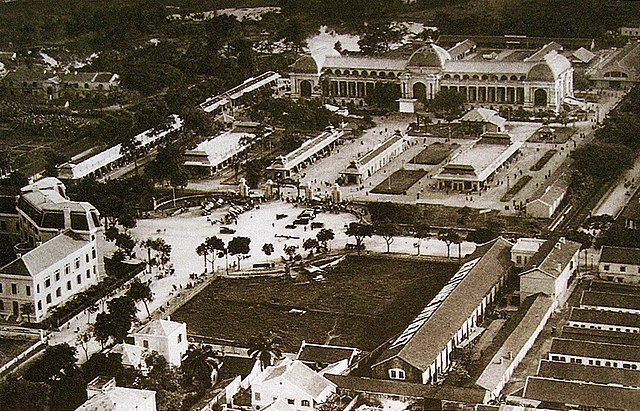Top Qs
Timeline
Chat
Perspective
Hanoi Exhibition
1902 world's fair in French Indochina From Wikipedia, the free encyclopedia
Remove ads
The Hanoi Exhibition (Exposition de Hanoi) was a world's fair[1] held in Hanoi in then French Indochina between November 16, 1902,[1] and February 15[2] or 16,[1] 1903.
Remove ads
Context
Hanoi had become the capital of French Indochina earlier in 1902 replacing Saigon. Earlier activities to mark the change included a festival on 26 February 1902 attended by emperor Thành Thái and the governor general Paul Doumer[2] and the opening of the Paul Doumer (now Long Biên) Bridge.[2] The exhibition was the idea of Paul Doumer.[3]
Grand Palais de l'Exposition

The site of the fair was the racecourse established in the early 1890s,[3] and its main building was the Grand Palais de l'Exposition (Vietnamese: Nhà Đấu xảo) designed by Adolphe Bussy.[4]
The preparation for the fair, especially the construction of the exhibition palace, left Hanoi's budget in deficit for a decade.[3]
When the Japanese took over Vietnam, they based their military and supply in the palace. Later, air raids at the end of World War II completely destroyed the building.[4]
The modern site of the palace now stands the Friendship Cultural Palace (Vietnamese: Cung Văn hoá Hữu nghị), a concert venue in southern Hoàn Kiếm District.
Remove ads
Participation
The fair showed products from France and her colonies, and from other territories in Southeast Asia: , Burma,[2][5] Ceylon, China, Dutch Indies, Formosa (now Taiwan), French Indo-China, India, Japan, Korea,[5] Malaysia, Malacca, the Philippines, Siam and Singapore.[2][5]
Exhibits
As well as country displays there was a machine gallery,[6] a La Grand Roue amusement ride,[7] and art in the French Section of Fine Arts including work by Carolus-Duran.[4]
References
External links
Wikiwand - on
Seamless Wikipedia browsing. On steroids.
Remove ads

